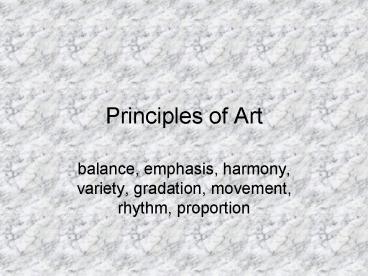Principles of Art - PowerPoint PPT Presentation
1 / 10
Title:
Principles of Art
Description:
Kingdom of Benin, Edo people, Nigeria. Mounted King with Attendants. 16th-17th century. Bronze. * * Title: Principles of Art Author: – PowerPoint PPT presentation
Number of Views:327
Avg rating:3.0/5.0
Title: Principles of Art
1
Principles of Art
- balance, emphasis, harmony, variety, gradation,
movement, rhythm, proportion
2
Balance
- A way of combining elements to add a feeling of
equilibrium or stability to a work of art - Symmetrical balance means formal balance two
halves of a work are identical - Asymmetrical balance is more informal
- Radial balance occurs when objects are positioned
around a central point.
3
Emphasis
- Also called contrast
- A way of combining elements to stress the
differences between those elements
Georgia Mills Jessup. A Rainy Night Downtown.
1967 Oil on canvas.
4
Harmony
- A way of combining similar elements in an artwork
to accent their similarities
Liubov Popova. Painterly Architectronics.
1918. Oil on cardboard.
5
Variety
- A way of combining elements in involved ways to
create intricate and complicated relationships. - A picture may be made up of many different hues,
values, lines, textures, shapes, etc.
Max Weber. Chinese Restaurant. 1915. Oil on
canvas.
6
Gradation
- A way of combining elements by using a series of
gradual changes in those elements. - May be a gradual change from a dark hue to a
light one, or from a small shape to a large one.
Antonio M. Ruiz. School Children on Parade.
1936. Oil on canvas.
7
Movement
- The principle of art used to create the look and
feeling of action or motion. - Guides the viewers eye throughout the work of
art. - Also used to direct
- the viewers eye to
- the center of interest.
8
Rhythm
- The careful placement of repeated elements in a
work of art to cause a visual tempo or beat. - Invite the viewers eye to jump rapidly or glide
smoothly from one element to the next.
Marcel Duchamp. Nude Descending a Staircase 2.
1912. Oil on canvas.
9
Proportion
- The principle of art concerned with the
relationship of certain elements to the whole and
to each other. - Very similar to emphasis- with proportion, the
large shape is emphasized and is dominant
Kingdom of Benin, Edo people, Nigeria. Mounted
King with Attendants. 16th-17th century. Bronze.
10
The Design Chart
- Helps you identify the many possible
relationships between elements and principles in
works of art. - See the Design Chart on page 46 of the text.































